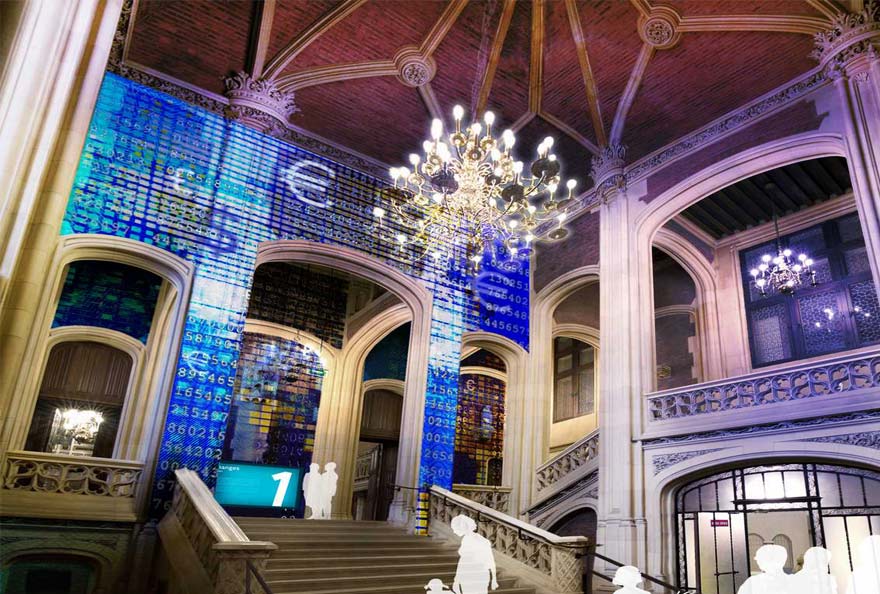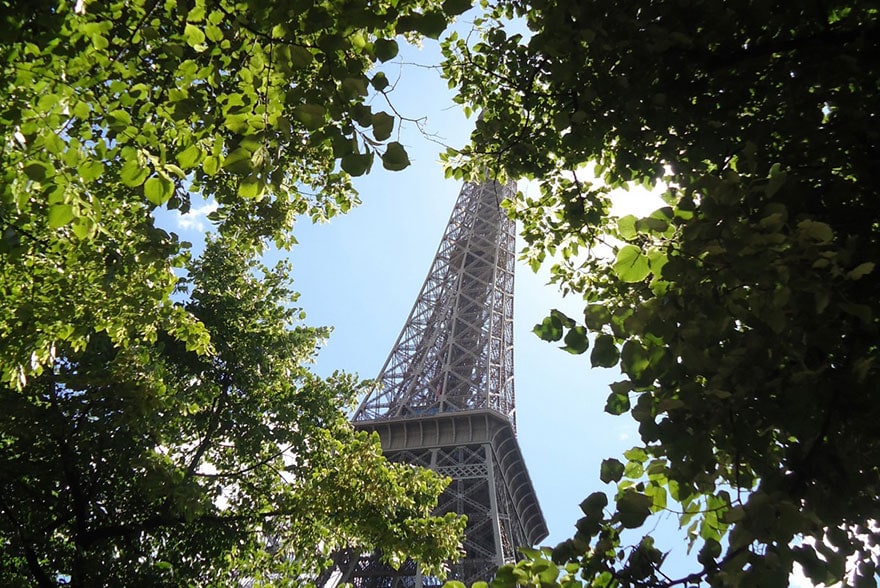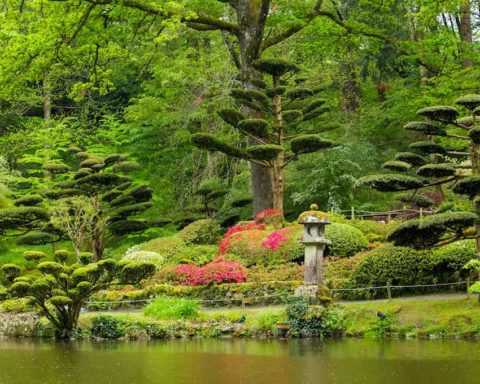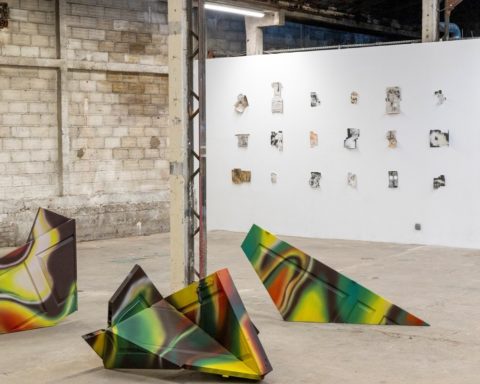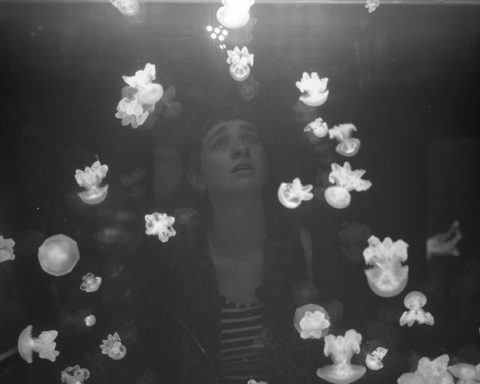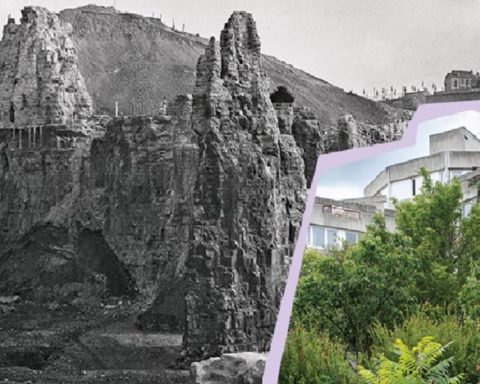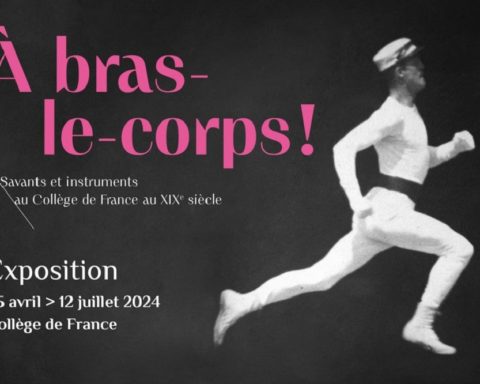On 14 June, the first interactive museum in Europe dedicated to the economy opens in Paris. In the heart of the Gaillard Hotel, a masterpiece of neo-Renaissance architecture and former branch of the Banque de France, Citéco is deploying a permanent exhibition covering more than 2,400 m2 offering a fun and educational access to the concepts, mechanisms and challenges of the economy. The cultural programme will host temporary exhibitions, meetings, conferences, workshops, screenings and live performances, which will punctuate each season of this new Parisian cultural institution.
Mut why an economic city in Paris when everything related to the financial ecosystem does not have a good press today, especially in France? For the Governor of the Banque de France, President of Citéco, "The economy must be made more accessible and understandable to all.
The Cité de l'Économie is one of the highlights of this educational approach. A unique museum project in the heart of Paris, Citéco aims to answer the questions of visitors of all ages and to generate new ones, invite debate and enrich exchanges, stimulate curiosity and open up new horizons. The challenge is a major one: to help visitors - especially the youngest - to become familiar with the various economic theories and to better understand the main mechanisms at play.
For the President of Citéco:"Through an innovative edutainment installation and museography, we wanted to provide visitors with collective and interactive games as well as a multitude of teaching aids. A place for meetings and exchanges, the Cité has temporary exhibition rooms and offers lecture cycles, master classes, live shows, etc." "Located in the heart of an exceptional historical monument, the Gaillard Hotel, the Cité de l'Economie also wants to contribute to the enhancement of France's extraordinary heritage. The Cité de l'Économie is thus the most recent and spectacular example of the central bank's commitment to an educational approach accessible to all. Designated in 2016 by the government as the operator of the national economic and financial education strategy, the Banque de France has developed numerous educational initiatives over the years, including a close partnership with the National Education Ministry, associations and synergies with major universities, and participation in events throughout France. It has thus been a privileged partner of the Journées de l'Économie since its creation in 2008. At the heart of Europe, at the service of the French people, the Banque de France has three main missions: financial stability, monetary strategy and economic services. In this respect, the economic and budgetary education of citizens is fundamental. In order to enhance everyone's economic knowledge and enable them to make informed financial decisions. »

The installation of the Cité de l'Économie in the Gaillard Hotel in the 17th arrondissement of Paris is an opportunity to discover a unique building, classified as a historical monument, typical of the 19th century, which once belonged to the banker Emile Gaillard (1).
The third life of a building
A banker's residence, then a bank branch, the history of the Gaillard Hotel predestined it to become the first European interactive museum dedicated to the economy. To accommodate the public spaces and the permanent Citéco route, the Hôtel Gaillard has undergone an architectural transformation and heritage restoration.

A complex project
Citéco takes place in a listed building, a structure with disparate volumes that had to be transformed into a cultural city accessible to all audiences, in compliance with safety and accessibility standards. Due to the nature of the building, the architectural project was preceded by a historical analysis and a meticulous examination of the sanitary state of the facade, roofs, floors, openings and joinery. "We slipped the project into the existing building."says Éric Pallot, architect of the Monuments Historiques. This formula perfectly sums up the approach used to draw up this complex project, the result of a joint reflection with Ateliers Lion Associés, representative of the group that won the competition in 2010. "We are in a neo-Renaissance, Loire Valley architecture, a building representative of the work of the architect Jules Février, which has been respectfully reinterpreted by Alphonse Defrasse.he continues. The same approach animated us. Thus, Gaillard III is designed in respect of Gaillard I and Gaillard II. In addition, we have integrated a contemporary approach that is as discreet and minimally invasive as possible. A concealment that required a lot of work and a permanent dialogue with the scenographers. »
Gaillard III does not let you guess that the air handling system is hidden in the furniture of the scenography, that the windows and stained glass windows have invisible double glazing, that doors in the neo-Renaissance spirit have been added and that the whole structure has been treated thermally and acoustically.
Three major interventions
The architectural project consists first and foremost in "breathing" the Gaillard Hotel: purging the interior of the blocks, thus making the different architectural layers of the building visible, flooding the interior of the building with light and creating a terrace with a view of the rooftops. The gap between Jules Février's building and the hall built by Alphonse Defrasse had disappeared as a result of concrete additions. This space was purged, clearing an inner courtyard and freeing up openings that had been blocked. Protected by a glass canopy that follows the contours of the building, the courtyard is home to the café and also provides a key passage in the heart of the building. The composite nature of the building becomes apparent and one can once again admire the volumes of the elegant interior turret, which housed the service staircase. It has been completely restored.
On the roofs, the creation of a terrace space, which cannot be seen from the façade, is the contemporary "gesture" of Ateliers Lion Associés. This new plateau, intended for receptions and temporary exhibitions, is entirely glazed and allows visitors to discover the architecture of the original roofs. Finally, the ground floor has been redesigned to accommodate the reception hall to the right of the main entrance. Located under the ballroom and just above the new auditorium in the basement, this hall includes the ticket office and the shop.
Excellence at the service of Gaillard III
From the floor to the finials, the restoration of the building required the intervention of many trades with recognised know-how in the treatment of stone, brick, lead, zinc, slate, wood, iron, stucco... Let us mention in particular the Lefèvre company for the façade, where part of the bricks had to be redone to the same size, in the red colouring or black glaze for the diamond-shaped motifs; the Ateliers Tollis for the sculptures, the Ateliers Duchemin for the stained-glass windows; Mathieu Lustrerie for the lighting, or UTB for the roofs.
Echoes from the site
The metamorphosis of the Gaillard Hotel required several years of work: a complicated project, as David Jolly, architect of Ateliers Lion Associés explains: "The Gaillard Hotel is a complex building, classified as a historical monument. It is a heterogeneous patchwork - between the original structure and the refurbishments carried out by the Banque de France - which presents very disparate volumes and discontinuous floors. Previous architects have multiplied the effects. Moreover, although the hotel gives an impression of solidity from the outside, it has its weaknesses. The interior is made of iron, steel, fake bricks, castings and stucco decorations. These frailties were not apparent; everything was "wrapped up" in the arrangements made in 1920 to create the Banque de France branch. The building site revealed weaknesses that required major work: reinforcement of the floors, flocking of the beams, consolidation of the structure. It was also necessary to remove asbestos and plumbing. » Interventions which partly explain the duration of the construction site.
Discovering a new museum - Two assets: heritage and economy
The route: from the basement to the roofs
The main access is through the historic entrance located at Place du Général-Catroux. The ground floor hall, which opens onto the building's inner courtyard and the Gaillard café, gives access to the ticket office and the shop. To begin the tour of the permanent exhibition, visitors can climb the Great Staircase, in a chronological order of routes, or go directly to the vault. The first contact is spectacular: the arcades and columns of the monumental staircase serve as a backdrop for animated graphic projections illustrating the major issues of the economy. The permanent exhibition covers 2,400 m2 on three levels, from the basement to level 1. Following the initial distribution of the rooms in the Gaillard Hotel, the tour takes place over several rooms, particularly on the upper floors. On two levels, the vault room, surrounded by a water-filled moat, has become an emblematic space of the banking function, where collectors' items such as banknotes, coins and machines are displayed. The temporary exhibition area is located on the 3rd floor, with a surface area of 430 m² and is accessible from the reception desk. It is part of the volumetric roofs of the building and is linked to the terrace around the dome of the Hall Defrasse. Two educational workshops have also been created on level 3 and benefit from the new glazed roof volumes. Two projection rooms are integrated into the course, one at the mezzanine level to explore 200 years of economy and the other in the former office of Émile Gaillard.
The scenography, a radical gesture
Staging an introductory course in economics in the former rooms of a private mansion and the spaces of a bank branch: the challenge was considerable, as Véronique Rozen, from the "Explosition" agency in charge of project management for the scenography, explains, following the cessation of activity of the Confino agency: "We worked in an exceptional but constraining environment. The coherence of the economic approach, with its 6 themes, combined with the structure of the building dictated the course. Moreover, with the exception of the Galerie Thann, all the spaces in which this tour is deployed are heritage areas. The question therefore arose: either the scenography blended in with the decor, or it gave itself to be seen. It was the latter option - with which we won the competition in 2010 - that was chosen. Thus, in the neo-Renaissance set designed for Émile Gaillard, the contemporary scenography is a radical gesture with a strong identity. The museum itinerary is distinguished by the colours of the walls and the furniture, it is punctuated by devices, some of them spectacular, and does not interfere with the heritage trail. However, whenever possible, we have integrated existing elements into the scenography by treating them in a contemporary manner: for example, we have dressed the heritage chandeliers on the mezzanine floor, transformed the old vault cabinets in the vault room into display cases, used existing furniture (booths, counters, counters) to integrate devices, and enhanced the tiling of the bathroom in the director's office to project the words related to money. »
The markers: 6 sequences, colours and totems
Step by step, the course deals with economic notions. The first three sequences describe the fundamentals of the economy: exchange, actors and markets. The next two sequences deal with the instabilities and crises that institutions seek to regulate. The last sequence, "Treasures", presents objects related to the banking function. Each sequence, numbered, is introduced by a large backlit entrance totem pole. Room totems punctuate the tour and synthesise the themes addressed by the different devices. Focus" totems provide in-depth information on a subject, while brown "heritage" totems tell the history of the building, its architectural evolution and highlight the remarkable decorations. Cartels and totems are available in three languages: French, English and Spanish. Each sequence has its own colour which has been carefully chosen. For sequence 1, the dominant duck blue is a reminder of the tapestry tint of Émile Gaillard's dining room. Red, the signature colour of the Confino agency that initially designed the scenography, was chosen for sequence 2, deployed in the former reception rooms of the mansion. Grey-green shades dress the furniture in the former ticket office in the lobby.

A Challenge: Making the Economy Attractive
As the only museum dedicated to the economy in France, Citéco claims its educational mission. In an unexpected setting, the interactive museography and its cultural offer aim to appeal to all audiences.
The birth certificate
You have to cross the Atlantic to find the equivalent of Citéco and go, as the governor of the Banque de France who initiated the project did, to Mexico City to visit the MIDE, Museo Interactivo de Economia, the first museum in the world dedicated to the economy, created in 2006 by the Central Bank of Mexico. An inspiring example for the Banque de France. Using the monumental spaces of the Gaillard Hotel - free of any banking activity since 2006 - and based on the lessons learned from the MIDE, it chose to design not a banking museum but a more generalist museum, a city for popularizing the economy. The exhibition: "The economy: crash, boom, moult...", at the Cité des Sciences et de l'Industrie in 2013, of which the Banque de France was a partner, foreshadowed Citéco. The foundations had been laid and the idea had yet to be transformed. It took 10 years to complete this complex project.
An educational mission
Citéco is part of a national economic education strategy entrusted to the Banque de France in 2015. In accordance with the determination of its supervisory authority, the General Council of the Banque de France, Citéco is aimed primarily at a young audience. The aim is to bring schoolchildren and students to discover in a different way a subject that only fully enters the school curriculum in the second year of secondary school.
Citéco's educational vocation is based on the observation that the economy is omnipresent in our daily lives. However, the discipline can be frightening because it involves social sciences, humanities, history but also mathematics.
A place of acculturation to the economy
Citéco does not claim to teach economics in a few hours of visit, but aims to seduce all audiences with its assets: the interactivity and the exceptional character of the building. The height of the ceiling, the sculptures of the doors, the bases, the mullioned and transomed windows... the astonishment is not limited to the façade, it goes crescendo to the vault room. The presence of very sharp devices in neo-Renaissance decorations gives Citéco a unique identity. "The heritage asset is a very important vector of seduction", underlines Xavier Limagne, museographer, who has followed the project since 2009. He adds : "On a subject as rich as the economy, you don't have to say everything, but you have to be interesting, sharpen curiosity, raise questions; offer several levels of understanding: very simple, moderately learned and very learned, and offer the visitor ergonomic devices that respond to the quarter turn". As at the MIDE, interactivity is the keyword of the permanent tour, as Xavier Limagne points out: "Economics is a discipline that provokes debate. The quantity of conversations generated, at the end of a team or a game, will be a criterion of success for us. The attractiveness of team games is one of the challenges of Citéco, a city designed to be a place where people can exchange and debate with friends, teachers and mediators.
A discovery in 6 sequences: Exchanges - Actors - Markets - Instabilities - Regulations - Treasures
The tour of the permanent exhibition begins in the monumental staircase: an immersive audiovisual show presents the major issues of the economy: production, consumption, exchange and money, which concern each and every one of us on a daily basis. The route is not constrained, but the order of the sequences has been designed to allow each person to tame the economic mechanisms at his or her own pace.
Trade in goods and services
The very foundation of economic activity. In everyday life, we acquire goods (e.g. a bicycle) or services (e.g. renting a bicycle), we buy or sell. These exchanges of goods and services are the foundation of economic activity. In order to better meet each other's needs, some specialize in particular areas of production. But for transactions to take place, it is necessary to be able to set values and have means of payment. How do these exchange values vary? What role does money play? And what forms can these exchanges take? What influence do they have on economic development?
In the former dining room of Émile Gaillard, a toaster is enthroned.
Sequence 1 takes place in Émile's private apartments, where the theme of exchanges is addressed in small rooms with sumptuous fireplaces and walls covered with woodwork. As soon as you enter, the tone is set, two devices occupy the dining room: an interactive game and the original story of an everyday object, a toaster. Its components illustrate the fact that one cannot do everything oneself to satisfy one's needs, as shown by the (filmed) experience of the English artist Thomas Thwaites: this banal object is in fact of great complexity, with some four hundred pieces made from a multitude of raw materials that one must know how to produce and assemble. The young artist spent nine months running from disused mine to plastic landfill in order to gather the essential elements for his project. From trial and error to failure, he finally succeeded in making an object of a very singular appearance, which only worked for a few seconds before melting on itself before the bread was toasted?

Barter or currency ...
Barter or currency: Economic exchange is generally based on the use of money. But it can also take the form of barter, which consists of exchanging one good for another - without using money. This theme is addressed by a device that involves five players. Each player has to feed his chicks, which ask for food, by exchanging with the other players. At the beginning of the game, only by means of barter, and at the end of the game, the use of money facilitates the exchanges.
The diversity of payment methods A series of devices and examples, used in different eras and civilizations as an instrument for measuring the value of goods, an instrument of exchange and reserve, familiarize visitors with what economists call money and us, money, wheat or sorrel, as is humorously evoked by a projection of words on the tile floor of the washroom adjoining what used to be the office of the branch manager. In antiquity, cattle were used as a unit of account, even as a currency of exchange, in Egypt as well as in India and Africa. A life-size cow in recycled metal, work by sculptor Christian Champin, reminds the visitor of this.
The actors: States, companies, banks...
The economy is based on multiple and continuous interactions between different actors such as businesses, banks, associations, the state or households (the occupants of the same dwelling) - that is, all of us. Goods, services and money are exchanged and circulate between these actors. What are the specificities of each one? How are they financed? And what interdependencies exist between them? Sequence 2 unfolds in the reception rooms painted in red. It is accessed through the richly decorated small lounge where a first original device is installed: everyday objects are scanned, as during an airport checkpoint, and reveal the diversity of the stages and places where they were made. Then one enters the sumptuous ballroom to discover the role of the various economic players.
The role of the state To appreciate the role of States as economic actors, a series of mechanisms deciphers the forms of intervention and invites us to look at the world in all its diversity. A collective game proposes to identify the services financed by the State in a given city.
In the skin of a banker To give concrete expression to the role of banks as economic players, a system offers visitors the opportunity to put themselves in the shoes of a banker who receives customers, whether they are loan applicants or concerned about investing their savings well. It is up to him to respond to these requests, taking into account the profile of his customers and the risk factor for the bank.
The Tower of Companies Diverse in size, status and objectives, the companies have in common that they derive most of their resources from the sale of products in the marketplace. A monumental facility - the business tower - illustrates their diversity. The windows on the ground floor, on the 4 façades of this decorative building, give access to portraits, slide shows and videos. 52 photos were taken by artists to highlight the variety of entrepreneurial situations. The "tower" is traversing and offers three features inside: a duo game to set up development strategies in two competing companies, by acting on three variables (cost reduction, innovation, communication); a team to learn about the accounting of a company, taking into account income and expenditure items; an audiovisual presenting the case of six different companies.
Markets - The interplay of supply and demand
We procure most of our goods and services from markets. These markets are very diverse. For example, there are markets for labour, real estate, or finance... In these markets, the meeting between buyers and sellers leads to the setting of prices at which exchanges or transactions take place. How are the markets organised? What are the mechanisms at work? What are the rules necessary for their proper functioning?
Strategies and scenarios After having taken the measure of the different types of markets through animated films, the visitor is put in a situation to understand how they work through simple manipulations. In a large demiurge, they can activate two giant wheels - the supply and demand wheels - to better understand how, on a given market, the meeting of these data determines the prices and quantities traded. A collective game plunges him, if he wishes, into the fluctuating stock market.
Relaunch or liberal politics? The efficiency of the market economy is discussed from a theoretical point of view. The theme of markets is thus an opportunity to broaden the reflection on the different facets of the economist's profession and on the history of economic thought. A large interactive fresco presents the currents and key figures in the history of the economy. Finally, based on a selection of questions, visitors can initiate an imaginary dialogue between two of the most influential economists of the 20th century whose opposing theses continue to be debated: John Maynard Keynes and Milton Friedman.
Instabilities - Turbulence of all kinds
The market economy has dysfunctions that can lead to crises. The interdependence of the players in the market economy is both a strength and a weakness, which is reflected in fluctuations in economic activity. In phases of expansion, the production of goods and services increases each year. In periods of recession, it declines. Crises are those particular moments when economic activity turns around, at the beginning of a recessionary period. How are these processes triggered? What are the consequences?
Depression, recession, unemployment... As soon as the visitor enters the sequence, he is jostled: he is invited to enter a large metal cylinder, a through space, which presents in the form of an installation, both sonorous and visual, the shocks linked to crises. From mild recession to deep depression, other devices address the causes, forms and mechanisms of crises: the rise in the price of raw materials, the bursting of speculative bubbles and the procession of events linked to recessions: crisis of confidence, social crisis, unemployment.
Imbalances: Within economies, many factors can generate instability. Smuggling and the underground economy, rising energy commodity prices are among them. An interactive game invites four participants, in the role of fishermen, to solve an imbalance in the exploitation of marine natural resources so that they can be reproduced. An original installation illustrates the domino effect and the interdependence of economic players, or how the failure of one player on the market leads to the downfall of others. The manipe allows a life-saving domino to be set in motion to stop the process.
Four major crises of the 20th century : Four films of interviews evoke the specificities of historical crises: the 1923 hyperinflation in Germany, the world crisis of the 1930s, the 1973 oil shock and, closer to home, the subprime crisis of 2007. Excerpts from fiction films (La vie est belle by Franck Capra) offer an escape route and allow us to take a step back from the harsh reality of crises.
Regulations - Preventive or corrective
The objectives of regulation are multiple and may be short-term or longer-term. Each of these objectives has its own specific instruments. How are they implemented? How effective are they? Correcting imbalances, improving collective well-being or trying to change the behaviour of stakeholders... how do the objectives and instruments of regulation help to prevent disturbances? What means do States have at their disposal to regulate?
The role of public institutions Fiscal policy, tax policy, compulsory levies, etc. are all tools available to governments to regulate and redirect the means of production, support innovation, stabilise economic activity, develop purchasing power and reduce social inequalities. The degree of intervention depends on the political and social choices of the different countries. Regulation is also a matter for European and international bodies.
Practical work : After having assimilated the regulatory instruments and discussed the rules governing exchanges between States, the visitor can move on to practical work and, for example, confront the delicate problem of financing pensions, by bringing into play two variables: the age of departure and the amount of pensions. A second team suggests that the visitor varies the ECB's key interest rate, with the aim of keeping annual inflation at around 2%.
The "boardroom" to simulate collegial decision-making: At the heart of the public hall are the walls of a large room, a semi-open volume where a total of 9 players and a minimum of 4 can take place around a large table. They are in the role of negotiators on behalf of a country and carry out a multilateral climate negotiation. Objective: to produce electricity by increasing the share of renewable energies while taking into account various parameters: the targets defined within the framework of the European Union, agreements between countries, the budget, taxation of non-renewable energies. On the walls of the room, two large screens display contextualized images.
Treasures - Money in All Its Forms
In the basement, the two levels of the former vault room are diverted from their original use to reveal treasures to visitors. The strong cupboards, transformed into showcases, no longer house the wealth of the former customers of the Malesherbes branch, but collectors' items. The original bank furniture, the old voting booths, in which customers were protected from prying eyes, are used as seats for audio-visual devices or manipulations.
Ten thematic alcoves approach silver in all its facets: its manufacture, circulation and evocation in the cinema, art and literature, with in particular an astonishing text by the writer Stefan Zweig on the "Underground", the name given to the room that houses the gold reserves guarded by the Banque de France. From proto-currencies (shells, pearls) to cheques and bank cards, the means of exchange bear witness to specific know-how and tell whole sections of economic and political history. The profiles of the Roman emperors and the kings of France, engraved in metal, were the first media for the men in power. Exceptional coins are displayed in showcases, including the golden shield of Saint Louis, struck in 1266, or the first franc of 1360, created to pay the ransom of King John the Good, a prisoner of the English.
Three big machines testify to the printing and striking techniques in connection with the evolution of techniques: an 18th century assignat press, the ...cutthroat, which gives a slight relief and makes banknote counterfeiting more difficult, and Nicolas Thonnelier's famous press, which replaced manual pendulum presses for minting coins.
The lure of gold An alcove is dedicated to the precious metal with the presentation of a real ingot (in a very secure showcase) and a fake gold bar (26.5 cm long for a weight of 12.5 kg) to appreciate the density of the metal. One can follow the gold price live and be reassured by looking at the photos of the Banque de France gold stocks (photos printed on the old vaults).
The life of a banknote: From the raw material of which it is made to the choice of its design, its printing and wear and tear, and its counterfeiting, we learn everything about the life of a banknote. The creative process is akin to an artist's work, as can be seen in a selection of banknotes emblematic of the French style. The focus is on the remarkable coins: the first banknotes, the assignats, and notes with extreme values, such as the 10,000 franc Bonaparte (issued in 1955). And you have fun creating your own banknote... which will have only the © Banque de France / Confino value as a souvenir of your visit.
The cultural offer: a new approach to the economy
How to make the economy accessible?
The economy is not, a priori, a museum subject and, in the approach to this discipline, all visitors are not equal. Mediation along the route of the permanent exhibition and the relevance of the cultural programme are therefore major issues. The aim is to bring the economy within the reach of all audiences, to give a concrete translation to the concepts developed by museography.
The essential role of mediators in the permanent process
If he or she wishes, the visitor can take the tour in complete autonomy, guided by the totems of the rooms and the cartels. However, in order to allow everyone to better master the discipline, the team in charge of the public wished to set up a new form of mediation. Mediators and facilitators will be present at different points along the route to answer visitors' questions, facilitate access to a game, a manipulation, or develop a theme related to a device. This live animation, with speeches or original proposals (mobile scooters in the exhibition spaces), is a strong commitment of the Citéco teams so that everyone can find their own rhythm of visit. As part of this mediation-conversation, the mediators will make the link with current topics, while relying on the devices of the permanent exhibition's route.
Citéco can be visited alone, as a tribe, a family or with your class.
Because of its heritage appeal and the variety of its economic science proposals, Citéco has the potential to appeal to a wide variety of audiences: schoolchildren, students, young adults, families, seniors, entrepreneurs... Taking this diversity into account, Citéco's cultural offer offers generalist formats accessible to all audiences and more targeted formats. Regular events are offered at adapted times (weekend workshops for families, evening events for young adults).
Special attention is paid to the young public and the school public (30% of visitors expected).
Specific formats are dedicated to them, in particular in relation to schools and curricula. 100 days before the end of the school year, just a few months before the baccalaureate exams, Citéco will propose activities to celebrate this highlight of the last year of secondary school (inter-school meetings). The program will follow the rhythm of the school year with proposals for young people, to be discovered as a family, during the holidays (thematic workshops, screenings); by festive appointments to announce, during a back-to-school evening, the themes of the season and celebrate the end of the school year with an Eco-Tree Festival.
All formats for all audiences
The economy is everyone's business and heritage is a very shared interest. Citéco has the assets to seduce the regulars of the cultural places and all the curious ones. All year round, guided heritage tours, thematic workshops, conferences and one Thursday per month, until 10 pm, Citéco will organize a serious and festive evening, suitable for 18-35 year olds. On the menu: lectures in the auditorium, but also live performances (music, dance) in the reception areas and the beautiful Great Staircase. Finally, Citéco will participate in its own way in major national events: the Night of the Museums, the Music Festival, the All-Nighter, the European Heritage Days. Also, every quarter, Citéco will give carte blanche to a fablab to host a creative moment open to all those who want to "do it themselves". Once every two months, "The Entrepreneurs' Lunch" will be a time for exchange on a given theme.
Targeted formats : Citéco is a place for meetings and exchanges (round tables, conferences, master classes), creation (workshops, fablab, game jam) and innovation (hackathon, prototype presentations, reuse...). Economic players, entrepreneurs and startups will be invited to bring Citéco to life during regular meetings. Finally, each year, the Innovation Masterclass will bring together students and entrepreneurs.
Citéco - Musée de l'économie, 1, place du Général-Catroux - 75017 Paris - Opening: 14 June 2019
www.citeco.fr
(1) In 1878, Émile Gaillard bought two adjoining lots on the Plaine Monceau. Formerly an area of pasture and market gardening, the plain was urbanized at the end of the 19th century; wise businessmen invested and bought plots of land there for resale. The district has solid assets: it is well served by the Boulevard Malesherbes and the Avenue de Villiers; there is plenty of space, it is chic, bourgeois and well frequented, especially by artists. Claude Debussy and Sarah Bernhardt have their residencies there.
Photos : ©Banque de France - Atelier Confino

